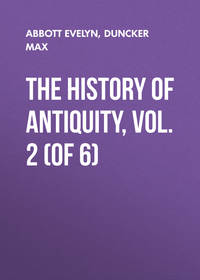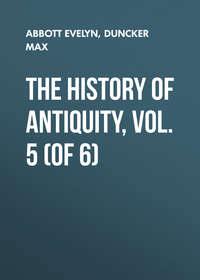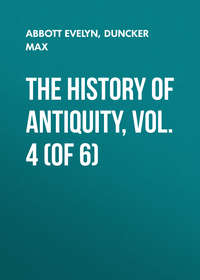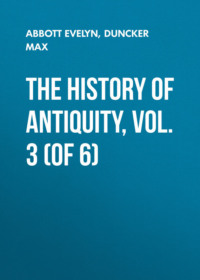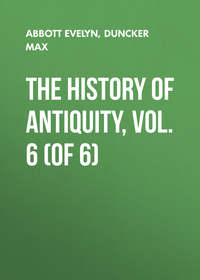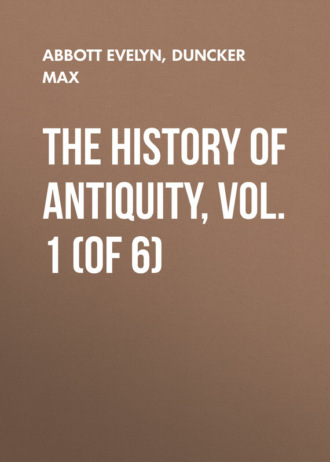 полная версия
полная версияThe History of Antiquity, Vol. 1 (of 6)
800
Plut. "Alex." 46; Curtius, 6, 5; Diod. 17, 77; Strabo, p. 505; Justin, 2, 4; 12, 3. Cf. Arrian, "Anab." 4, 15.
801
Arrian, loc. cit. 7, 13.
802
Plut. "Pompeius," c. 35; Appian, "Bell. Mithrid." c. 103.
803
Strab, pp. 503-505, 547, 550, 552.
804
Hippoc. "De aere," c. 89, 91. If the name Amazon were Greek, it could only have been invented in a contrast to πολύμαζος, "with many breasts," the epithet of the Ephesian Artemis, as the goddess of birth, to denote the maidens devoted to chastity.
805
Strabo, pp. 591, 680.
806
Herod. 1, 7, 94; 4, 45; Dion. Hal. 1, 27, 28; "Il." 2, 461; Strabo, p. 627; Steph. Byz. Ἀσία.
807
Herod. 1, 84; Xanth. Fragm. 10; Nicol. Damasc. Fragm. 26, 29, ed. Müller. The legend of Meles is obviously connected with the founding of Sardis. This Meles therefore cannot be identified with the Heracleid (the last but two) of the same name. In Nicolaus, Moxus is the successor of Meles; Fragm. 24, 49.
808
Xanth. Fragm. 11, 12; Nicol. Dam. Fragm. 25, 28, ed. Müller.
809
Diod. 4, 21.
810
Ephor. Fragm. 9; Pherecyd. Fragm. 3, 4; Mæandri Mil. Fragm. 8; Clearch. Sol. Fragm. 8, ed. Müller; Apollod. 2, 6, 3.
811
Pliny, "Hist. Nat." 25, 5. Cf. Nicol., Dam. Fragm. 49, ed. Müller, where Sadyuttes and Lixus are mentioned in the place of the Heracleidæ as the successors of Tylon, loc. cit. p. 382, 384.
812
Herod. 1, 7. According to Apollodorus (2, 7, 8), the son of Omphale and Heracles was Agelaus; according to Diodorus (4, 31) Heracles first begot Cleodæus with a slave, and then Lamus with Omphale. Others call the son of Omphale and Heracles Meleus (Meles). Others again represent Sandon, the son of Heracles, as the father of Damalisandus, or Dalisandus, by Damalis. Cf. Müller, on Nicol. Fragm. 28.
813
Joh. Lyd. "De Mens." 3, 14.
814
Brandis, "Münzwesen," s. 168, 386.
815
Hesych. Ἀτταγάθη Ἀθάρη παρὰ τῷ Ξανθῷ. The native name Athar-ath is found on a coin of Bambyke, in Brandis, loc. cit. s. 431.
816
Joh. Lyd. "De Mag." 3, 64; Plut. "Quæst. Graec." c. 45; "An seni resp." c. 4; Clearch. Sol. Fragm. 6, ed. Müller; Ovid. "Heroid." 83-118; "Fast." 2, 325.
817
Hupfeld, "Res Lyd." pp. 55, 63, 67.
818
Joh. Lyd. "De Mens." 4, 46; Lucian. "Dial. Deor." 13, 2.
819
Compare the Lydian names Sandonis and Sandoces in Herod. 1, 71; 7, 194.
820
Oppert, "Expéd. en Mesopot." 2, 337.
821
E. Schrader, "Theol. Studien und Kritiken," 1874, 2, 330.
822
Herod. 1, 93; Athen. pp. 515, 516.
823
Strabo, p. 641; Paus. 7, 2, 7.
824
Herod. 3, 48; 8, 105.
825
Paus. 1, 21; Kiepert, "Monatsberichte d. Berl. Akademie," 1866, s. 298.
826
Steph. Byz. s. v.
827
Lassen, "Z. d. d. M. G." 10, 382 ff; cf. G. Curtius, "Grundzüge."
828
Herod. 5, 102.
829
Herodotus (1, 7) says twenty-two generations. But as these, according to the length which he assumes for a generation, would give a much longer interval than 505 years, he can only mean twenty-two sovereigns. That lists of kings existed in Lydia is proved by the considerable number of names of Atyadæ given in Xanthus.
830
Cf. H. Stein on the passages of Herodotus quoted; in one class of MSS. Alcæus, Belus, and Ninus are not found. The city of Ninoë has been already mentioned (p. 567).
831
The year 549 B.C., the year of the capture of Sardis, will be proved below. I believe that we ought to maintain this statement. Herodotus' total of 170 years for the dynasty of Gyges is untenable in the face of the Assyrian monuments. According to them Gyges and Ardys were contemporaries of Assurbanipal, who reigns from 668 to 626 B.C. Hence for the 170 years of Herodotus we must adopt the number given by Eusebius, which is 30 years less, and the separate dates of the latter.
832
Bœckh, "Metrologie," s. 76.
833
Herod. 1, 94.
834
Plut. "De Mus." 6; Steph. Byz. Ἀσιάς.
835
"Il." 18, 291; 10, 431.
836
P. 572.
837
Pausan. 2, 22, 3; 5, 13, 7.
838
Æsch. "Pers." 52; Herod. 7, 74.
839
Strabo, p. 604, 605, 612; Pausan. 10, 12, 6.
840
Strabo, p. 469; Plut. "De Fluviis," c. 13.
841
Herod. 1, 171; 5, 119.
842
Thuc. 1, 8; Isoc. "Panath." p. 241. On the Carians in Samos and Chios, see Diod. 5, 84; Strabo, p. 457, 633-637, 661; Paus. 7, 2, 5, 8, 9, 10.
843
Archiloch. Fragm. 23, ed. Bergk; Euseb. "Chron." 1, 321, ed. Auch.; cf. Bunsen, "Ægypten," 5, 4, 5, s. 427.
844
Herod. 5, 118, 119; Strabo, p. 660.
845
"Il." 2, 872.
846
Alcæus and Anacreon in Strabo, p. 661; Herod. 1, 171.
847
Brandis, "Münzwesen," s. 338.
848
"Quæst. Græcæ," c. 45.
849
Lassen, "Zeit. d. d. M. G.," 10, 381.
850
Bœckh, "Corp. Inscript." 26, 93.
851
Ælian, "Hist. Anim." 12, 30.
852
1, 173; 7, 92.
853
Heracl. Pont. Fragm. 15; Nicol. Damasc. Fragm. 129, ed. Müller.
854
Strabo, p. 664.
855
Strabo, p. 665.
856
Herod. 1, 182; Serv. ad Æneid, 4, 143. Pausanias (1, 19, 3) says that the Lyceum at Athens was a sanctuary of Apollo Lyceus; the "Iliad" (5, 171) represents Lycaon as ruling in Lycia.
857
Lassen, "Z. d. d. M. G." 10, 335 ff; Blau, ibid. 17, 667.
858
Steph. Byzant., Ἄρνα: Fellowes, "Lyc. Coins," pl. 12, 7.
859
Blau ("Z. d. d. M. G." 17, 649 ff) sustains the first view, Savelsberg and M. Schmidt the second; M. Schmidt, "Lyc. Inscript."
860
Fellowes, "Account," p. 174, 194; "Lyc. Coins," pl. x. 1, 2, 3.
861
Ross, "Kleinasien," s. 57.
862
Lassen, "Z. d. d. M. G." 10, 348.
863
Ross, "Kleinasien," s. 51.
864
Ross, loc. cit. s. 35.


